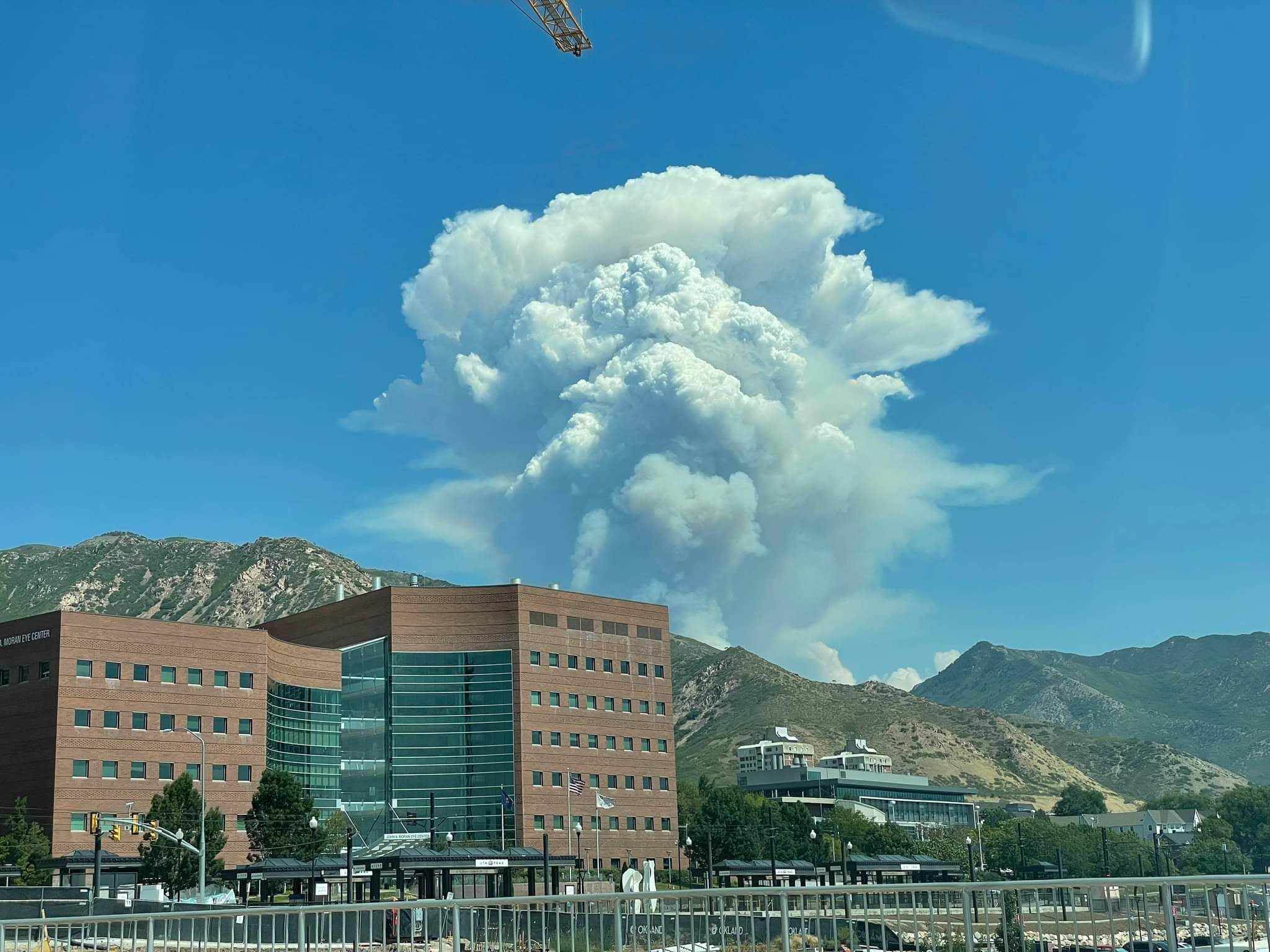
Anyone who has experienced the brown and gray haze of wildfire smoke in the last few years knows that it can be brutal. Wildfires can not only have devastatingly destructive impacts on communities where people live and work, they can also worsen air quality to unhealthy levels in areas downwind of these massive fires. People who study wildfires are using modeling to try to better predict where fires might occur and how they’ll behave. Someone who spends a lot of time studying wildfire smoke is Kai Wilmot, a post-doc in the Department of Atmospheric Sciences at the University of Utah. Wilmot is interested in atmospheric modeling of wildfire plumes to study how smoke is dispersed into the atmosphere, what it does to the atmosphere, and how this can inform and improve air quality forecasting. He’s currently pursuing development of a 5-day smoke forecast for the Western U.S. using trajectory modeling, physics based wildfire plume rise forecasting and satellite based estimation of wildfire emissions. (Featured image: The Parley Canyon fire, Utah, August 19, 2021. Photo courtesy of Julie Cunningham)
Listen to the interview
Transcript
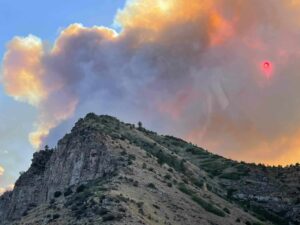
Kai Wilmot 1:31
I don’t know that there is like a single experience, mostly just like a childhood of growing up and spending a lot of time outdoors, you know, a lot of outdoor recreation and just kind of appreciating the mountains and rivers. I’m from the Pacific Northwest, so I was always hiking, skiing, kayaking, you know, whatever it be. So when I got to college, my interest was in environmental science broadly just an interest in the natural environment. And as I work my way through undergrad and made my way into grad school, I had an interest in climate and things, aspects of environmental science related to climate change. And then, to be honest, I sort of just kind of wandered into this particular subfield as far as atmospheric modeling and wildfires or emissions from urban centers. So, that part’s just a little bit by chance, but the overarching interest is kind of the natural environment, I guess.
Ross Chambless 2:32
I understand just from your background you were a you’re an athlete, right? You were you were a runner. And so I imagine, obviously it’s a beautiful place to grow up in the northwest, Pacific Northwest, and but, you know, it’s a place that’s been impacted certainly by this topic by by wildfires and and smog specifically. So, I mean, did that sort of play a role in your your consciousness of this?
Kai Wilmot 3:06
Oh, yeah. I feel like as I got kind of further into the atmospheric science realm, I mean, honestly, I still ended up on wildfires and smoke was like a little bit by chance, but like a little bit of, you know, kind of underlying interest. But, as I got my feet wet in it and started to think more about it, like, I guess one of the interesting pieces is just like as a kid growing up running in the Northwest, very, very rarely did we worry about smoke interrupting practice or kind of, you know, being an important aspect of planning our training. And then as I got into college, a lot of my friends that were still going home to train in the summer were constantly experiencing issues of trying to get in their training but avoid running in heavy smoke and things like that. So like kind of like 2015 onward, it felt like it was just constant, right? So, you know, I guess knowing that kind of experiencing it definitely bolstered my interest in the topic in the sense that there just a very concrete connection to impacts on my home and where I’m from.
Ross Chambless 4:08
Yeah. So I wanted to ask with, with specifically with your research sort of what what question or challenge have you been setting out to address when you started your inquiry into wildfire?
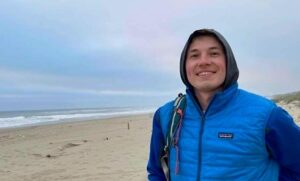
Kai Wilmot 4:25
I guess initially kind of the catalyst for my wildfire research was we know the air quality across the West is kind of getting worse during the summertime. We know that there’s more intense wildfire activity. Can we perform atmospheric modeling that concretely connects these two trends? Can we definitively say that wildfire emissions of smoke are degrading air quality in urban centers? I mean, I feel like intuitively, a lot of us feel like, yeah, that feels very obvious, especially if you’ve lived through it. But that was a bit of a missing piece in the literature. You know, we don’t unless you directly account for atmospheric transport of smoke and kind of take care of that underlying math, you know, work through those physics, you can say, yeah, we’re pretty sure that it’s from wildfire sources, but we wanted to really strengthen that link. So that was that was kind of the initial reason to get into it. And then as I’ve pushed forward into more recent studies, that that’s kind of morphed into, okay, like we can model smoke transport as caught in the atmosphere for past smoke events, can we leverage similar frameworks and ideas to understand where smoke might be? Three days from now, five days from now? How thick is that smoke going to be? What urban areas is it going to impact? How long will it stay there? Which is just very, very challenging and also very academically headed and fulfilling for me. It’s a very interesting question. And, you know, I think that we’re on the right track right now, and I think we have a lot to offer in that space. And there’s just so much work to be done in that area. So that’s kind of where it started and where it’s heading, I suppose.
Ross Chambless 6:07
That’s interesting. And I think one question might be just what are some possible real world applications with the work that you’re doing as far as how do you see it informing policy?
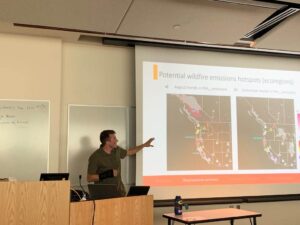
Kai Wilmot 6:24
I guess in the context of kind of forecast smoke, the maybe a more obvious application is just that you could kind of let people know when to expect air quality alerts. So like, for instance, you know, we might know, okay, the air quality is poor right now. It’s not actually poor right now, but, for the sake of the conversation, you could, you know, there’d be some sort of alert for the area. You’re like, okay, we’re in the, you know, the orange or whatever. So unhealthy for sensitive groups or it’s in the red. So unhealthy. Maybe I should avoid strenuous outdoor activity. So the idea would be, you know, can we basically let you know that that’s going to happen a couple of days in advance so you can, you know, plan your activities around that, just kind of factor that into decision making, you know, from the perspective of, you know, sensitive groups, I guess it seems like that would be even more relevant. And then I guess taking a little bit of a step back that the original push to think about this question was just sitting around and was like, well, is it going to be smoky and this is going to be smoky by a glacier a week from now? And I was like, you know, I don’t know, but it’s mid-August, so probably. So like, can we actually put some more accurate numbers around those kinds of questions? And yeah, I feel like that’s maybe a partial answer to your question.
Ross Chambless 7:51
I’m also guessing that we currently do not have this sort of forecasting power or a technology. I mean, it seems like we do to some degree, but it seems like there is room for improvement. Is that right?
Kai Wilmot 8:08
Yeah. It’s certainly an area that’s developing. I mean, there’s, you know, a handful of teams in the U.S. and in Canada that are working on this problem and kind of, you know, my sense as I look at the work that others are doing and kind of what we’re doing, it feels like everybody is doing parts of this very right and is struggling to fill in some of the gaps. And some of those are shared gaps. Right. So like issues that we’re struggling with, and issues that other groups are struggling with. So there’s a lot of space to improve these forecasts. I mean, right now you’re doing pretty well. If you get out, if you nail it two days out, that’s excellent. If you can provide some useful insight out to five days, also great. There’s really not a lot of you know, not a lot of of physics based guidance, I guess, to help guide that from that far out. It’s a very challenging problem to get a lot of room for growth just as a community in that space.
Ross Chambless 9:10
Yeah, and that sort of leads into my my next question and you sort of touched on it, but I mean, maybe in what ways do you perceive the work you’re doing that could lead into some certain kind of breakthroughs or impact or lead to solutions to to tackling climate change or at least how we are preparing for climate change in the future?
Kai Wilmot 9:35
I mean, in the context of preparing for climate change, I feel like the wildfire smoke forecast that we are doing, I guess there’s a few aspects of it that I think we are hoping there will be breakthroughs in this space. So to step back a little bit, I guess the big picture is hotter and drier. Conditions across the west are going to produce more intense wildfire activity across the West. Thus, you know, greater exposure to degraded air quality under a changing climate. So just to draw out the connection very concretely there. So then as we’re trying to forecast the smoke, one of the big challenges for the community is to forecast where wildfire smoke is going to be. You need to forecast what’s happening within the atmosphere, which, you know, we’ve been doing for quite a while now. And, you know, the forecasts are quite good. The other component of that is you need to forecast what the fire itself is going to do over the next few days. That’s extremely challenging. So the baseline assumption in smoke forecast is that tomorrow the fire will look like it did today, which, you know, in some senses it actually does pretty well. But there are certainly times where that is far from the truth. And I think, you know, a lot of us are aware of this, like there’s just these instances of extreme fire growth under windy conditions or something. And so an aspect of smoke forecasting that we’re really working on is trying to figure out, can we forecast what the fire is going to do over the next five days? Not only can we do that for one fire, but can we do that quickly and reasonably accurately for every fire occurring across the west? So it’s a bit of a computation problem, right? Like you, you have to create like a one size fits all tool that can be rapidly applied to potentially thousands of small fires, large fires across some area at the same time. And so we’ve been dabbling a lot in that space. And I feel like, you know, we’re feel like we’re tinkering around the edge of hopefully a breakthrough there. We’ve definitely produced some tools that we’ve determined are better in assuming that the fire is going to be the same tomorrow as it is today. But there’s still so much room for growth there. So I guess, you know, that’s kind of in a roundabout way, getting at this idea of preparing us for climate impacts, you know, trying to address these components.
Ross Chambless 11:53
Yeah, that’s very interesting. And I just wanted to ask maybe with your current research, I’m assuming you’re kind of still at research gathering, but potentially interpretation phase with do you, do you have any kind of timeline or this, you know, in next year or so, do you do you expect I don’t know, do you anticipate reaching a point where you can draw some important conclusions with your current research, or are you just kind of constantly kind of gathering season to season as far as what you can find out?
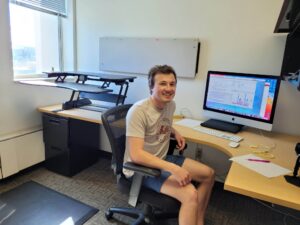
Kai Wilmot 12:33
I guess I’m going to say we expected to be pretty iterative. We think we are coming to our conclusions, but we’re finding useful pieces of information and useful kind of tools for modeling these things that maybe give us leverage to improve forecasts. But just given the uncertainty around a lot of these components, we expect that to continue to evolve as we move forward. So as new satellite data sets come online, that’s going to be game changing for us. Computational power expands and we can run more code in the same amount of time. That’s going to be game changing for us. At the same time, taking the data that we already have and spending more time crunching those numbers, testing different hypotheses, trying to find, you know, what’s the best way to represent, you know, growth of wildfires within our air quality model or the best way to represent wildfire plume rises. So, you know, as heat comes off the fire and injects smoke up into the atmosphere, can we get better at estimating how high that smoke is going to go? Because that’s relevant to where it will go after it’s ejected into the atmosphere. So, I expect this to be extremely iterative moving forward. And, you know, not just for us, but for other groups, for the community as a whole. This is a challenging, challenging question that is going to take a long time to to really nail down, I think.
Ross Chambless 13:52
Okay, well, what is your favorite aspect of your research?
Kai Wilmot 13:59
Ooh, that’s a good question. You know, at the moment I’m really enjoying digging into this wildfire plume rise problem. So, estimating how high smoke will be injected into the atmosphere from a given fire is extremely challenging. It’s recognized by this, there’s a small plume rise community. And for quite a while it seems like we’ve collectively been beating our heads against the wall. You know, people have definitely made progress, but it’s just a challenging problem and trying to figure out, you know, when when plumes are going to produce these extremely large clouds, know pyrocumulonimbus, a fire driven thunderstorm, problems like that, you know, it’s just from an academic perspective, I find it very, again, fulfilling. Yes, I find that part definitely interesting. And then stepping back a little bit, I’m definitely enjoying digging into the smoke forecasting from the perspective that I feel like if we can really make these tools more effective, you know, that could have on the ground impacts for people sooner rather than later. So, you know, I guess like there’s always a fear that you’re going to build something that’s useful and accurate and interesting, and then you’re going to write a few papers on it and it might get shelved. And I think we’re we’re trying really hard to push away from that and try to build a tool that we think is going to be useful for people.
Ross Chambless 15:28
Okay, great. Well, final question and tell us what what do you like to do when when you are working on research?
Kai Wilmot 15:36
All right. when I’m not working on research, Utah’s a great place to live for outdoor recreation. So, you know, checking out the trails, hiking, getting into snowboarding. You know, I love going rafting with my friends and family a couple of times a summer outside of town, things like that. And I have a cute little puppy dog and I like to take her out to run around. You know, those are good times. So spending time outside ideally in clean air!
Ross Chambless 16:09
Well, that’s a great way to end it, Kai. Thank you very much.
Kai Wilmot 16:14
Yeah, absolutely. Thanks for having me.
Relevant Research and Articles:
http://lair.utah.edu/group/wilmot.html